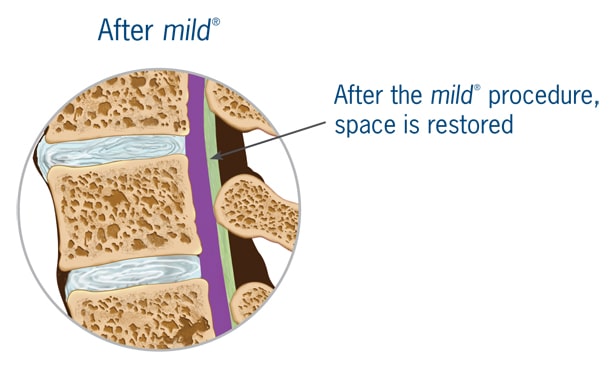A Non-Surgical Method for Lumbar Spinal Stenosis
By: Dr. Adam Hammer
Millions of people suffer from debilitating low back pain as the result of cumulative degenerative changes of the aging spine. This includes degenerative disc disease, facet joint arthritis, and commonly spinal stenosis. We are happy to announce a new alternative, Minimally Invasive Lumbar Decompression (MILD.)
Typical lumbar spinal stenosis manifests as low back pain that radiates into the buttocks and occasionally the back of the thighs. This pain occurs from standing and ambulation. Patients frequently have progressively shorter walking tolerance and must stoop forward or sit down to obtain symptomatic pain relief. An imaging study such as an MRI or CT scan aids the physician in making a diagnosis.
Treatment Methods for Lumbar Spinal Stenosis
For years, the gold standard for the definitive treatment of lumbar spinal stenosis has been open surgical decompression, involving the removal of the lamina (laminectomy) and portions of the ligamentum flavum, which directly surround the spinal nerves implicated in the pain of spinal stenosis.
Other treatments that are temporizing and can frequently provide pain relief include injections of anti-inflammatory medication into the potential space surrounding these nerves- also known as epidural steroid injections. These injections are performed fluoroscopy. Fluoroscopy shows a continuous X-ray image. Therefore, it ensures the safety and precise delivery of medication to the correct targeted areas in the spine. Furthermore, steroid injections are an effective treatment for spinal stenosis. However, they need to be repeated regularly.
Understanding Minimally Invasive Lumbar Decompression
The MILD procedure provides the best of both worlds. It is a safe, outpatient procedure with little recovery time. During this procedure, the guidance of a fluoroscope or x-ray machine is used. And it is done through a needle similar to an office epidural steroid injection. However, it is achieved through a MILD needle-introducer. And it is also very to the traditional surgical treatment for spinal stenosis. Next, a device is inserted through the MILD cannula. This device is designed for removing portions of the lamina and ligament that are “strangling” the spinal nerves, therefore, causing stenosis pain.
Recovery from the MILD is the same day, and most patients report immediate symptomatic relief and improved walking. The MILD data thus far continues to be excellent at the two year follow-up period. Patients have sustained improved low back and buttock pain. Plus, improved walking tolerance, and overall better quality of life.
Are you are suffering from low back pain and lumbar spinal stenosis? And looking for a new and proven effective alternative to injections and spine surgery? Then, ask your doctor if the MILD procedure might be appropriate for you.
Call us at 888-409-8006 if you are searching for a specialist near you. Our offices are conveniently located throughout South Florida.







Leave A Comment